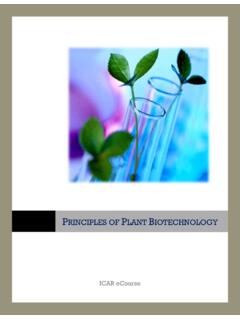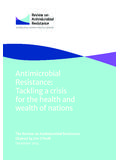Transcription of Factors affecting microbial growth in food
1 Factors affecting microbial growth in food RNDr. Jarmila Pazlarov , PhD. Factors affecting microbial growth in food Intrinsic Factors Environmental Factors Implicit Factors Processing Factors Intrinsic Factors Nutrients pH and buffering capacity Redox potential Water activity Antimicrobial constituents Antimicrobial structures Nutrient content The concentration of key nutrients can, to some extent, determine the rate of microbial growth . The relationship between the two, known as Monod equation, is mathematically identical to the Michaelis-Menten equation of enzyme kinetics.
2 It reflects the dependence of microbial growth on rate-limiting enzyme reaction. Monod equation = mS / S + Ks specific growth rate m maximum specific growth rate S concentration of limiting nutrient Ks saturation constant pH and buffering capacity As measured with the glass electrode, pH is equal to the negative logarithm of the hydrogenion activity. For aqueous solutions pH 7 corresponds to neutrality, pH values below 7 are acidic and those above 7 indicate an alkaline environment. In general bacteria grow fastest in the pH range , yeasts and filamentous fungi Redox Potential - Eh An oxidation-reduction potential of environment -Difference of platinum electrode potential placed into given environment and potential of standard hydrogen electrode.
3 Oxidace reduced matter oxidated matter + n elektrons redukce Reduction of redox potentialu -Addition of reducting compounds - growth of aerobic microorganisms -Vakuum package , etc. Water activity - aw Water activity -Is defined as the ratio of the partial pressure of water in the atmosphere in equilibrium with the substrate p (p), compared with the partial pressure of the atmosphere in equilibrium with pure water at the same temperature (p0). p aw = p0 -Amount of water available for microorganisms to metabolize -Optimal value for majority of microorganisms aw>0,98 Water activity - aw Lowered Water Activity (aw) Lowering aw is one of the earliest methods of food preservation used by Man - (partial) drying, addition of salt or sugar Still part of the modern diet - jams, hams, hard cheeses, pasta etc.
4 Many modern bakery goods, snack foods and cereals are preserved using the ancient methodology combined with modern processing techniques removing water by (partial) drying) aw can be lowered by addition of solutes (preserving) Foods can be classified by their aw value: Fresh foods Wet foods Intermediate Moisture Foods (IMF) Dried foods < Bacteria can grow down to aw = (S. aureus and some salmonellae) and moulds to aw = IMF contain 15 30% moisture and include dried fruits, jams, and some cakes and sauces aw - microbial response Accumulation of Compatible Solutes microbial response to lowered aw Modification of Membrane Lipid Composition Compatible solutes (CS) are accumulated intracellularly Typical CS accumulated by food -associated microbes include.
5 Betaine and derivatives Peptides, amino acids ( glutamate, proline) Carnitine Trehalose, sucrose Mannitol, glycerol K+ There is no correlation between the ability to withstand low aw and the type of CS accumulated Bacteria tend to accumulate N-compounds, moulds mainly sugars/sugar alcohols Lowered aw - microbial response Lowered aw Cell senses change via two-component regulatory system Influx of K+ ions (universal compatible solute) Altered gene expression Altered gene products Accumulation of CS Altered membrane lipids Restoration and maintenance of cell enzyme and membrane function Antimicrobial Barriers and Constituents Physical barrier to infection: skin.
6 Shell, husk or rind of the product. Usually composed from macromolecules relatively resistant to degradation and provides unhospitable environment for microorganisms by having a low water activity, a shortage of readily available nutrients and often antimicrobial compounds such as short chain fatty acids (on animal skin) or essential oils (on plant surfaces). Effect of antimicrobial substances Some substances present in environment display negative effect on microorganisms, based on their specific composition (antimicrobial). Microbistatic - compounds stop division of microorganism Microbicidal compounds killing microorganisms Effect of concentration (stimulatory effect) Types of antimicrobial effects Compounds demaging structure of cell or its function (cell wall, cytoplasmatic membrane, ribosomes) Compounds affecting microbial enzymes (oxidative agents, chelating agents, heavy metals, antimetabolites) Compounds reacting with DNA ( chemical mutagenes alkylating or deaminating agents, cytostatics) Presence of antibacterial compounds (biocides)
7 In food Some foods contain natural antimicrobial compounds (spices, mineral oils, garlic, mustard, honey ) Raw cow milk contain lactoferrin, lactoperoxidase system, lysozym, kasein Eggs contain lysozym, conalbumin, ovotransferrin, avidin Antimicrobial enzymes They are abundantly spread in nature and are very important in defensive reactions between living microorganisms. Hydrolases degrade basic structures of the cell walls (peptidoglycan) Oxidoreduktases produce reactive molecules, that degrade vital cell proteins. Antimicrobial enzymes Bacteriolytic catalyze splitting of glukosidic bonds of saccharides in peptidoglycan catalyze splitting between saccharidic peptidic part of peptidoglycan hydrolyze peptidic bonds of peptidoglycan chitinases , -glucanasea Antimicrobial enzymes Oxidoreductases Glucosooxidases are produced by some molds, princip of cytotoxicity lies in the formation of hydrogen peroxide (glucose oxidationce on gluconic acid and H2O2) Lactoperoxidases occur in milk and saliva (thiocyanate oxidation on hyperthiocyanate)
8 Lactoferrin is a glycoprotein forming complexes with Fe ionts Environmental Factors -Relative humidity -Temperature -Gaseous atmosphere Relative humidity Relative humidity and water activity are interrelated, thus relative humidity is essential a measure of the water activity of the gas phase. When food comodity having a low water activity are stored in an atmosphere of high relative humidity - water will transfer from the gas phase to the food . Temperature Is one of the most importatnt environmental Factors , controlling the rate of cell division (multiplication) of microorganisms We recognize 3 basic temperatures minimal temperature optimal temperature maximal temperature Division of bacteria according their relation to temperature Microorganisms are divided to groups according their demands on optimal temperature for division and metabolisms Psychrophilic bacteria (12-15 C) Psychrotrophic bacteria (25-30 C) Mezophilic bacteria (30-40 C) Thermophilic bacteria (50-70 C)
9 Cardinal temperatures for microbial growth Microorganisms belong to groups according to optimal temperature for division and metabolism Psychrophilic bacteria (12-15 C) Psychrotrophic bacteria (25-30 C) Mesophilic bacteria (30-40 C) Thermophilic bacteria (50-70 C) Effect of high temperatures Killing effect of high temperatures (lethal temperature) is the lowest temperature, at which under certain time are all microorganisms killed (70 C/10 min) denaturation of proteins, enzynme inactivation, DNA and cytoplasmatic membrane disruption is dependent on: species of microorganisms its fysiologic status cell concentration environment character Thermoresistance Degree of micoorganisms resistance depends on.
10 Fysiologic status of bacteria their genetic properties amount of bacteria water content in substrate quantity of protective compounds (lipids, proteins, saccharides) Appertization Processes where the only organisms that survive processing are non-pathogenic and incapable of developing within the product under normal conditions of storage. Appertized products have a long shelf-life even when stored at ambient temperature. Pasteurisation Properly done pasteurisation assure: devitalisation of pathogen microorganisms (M. tuberculosis) devitalisation of substantial portion of saprophytic microflora (vegetative cells)




